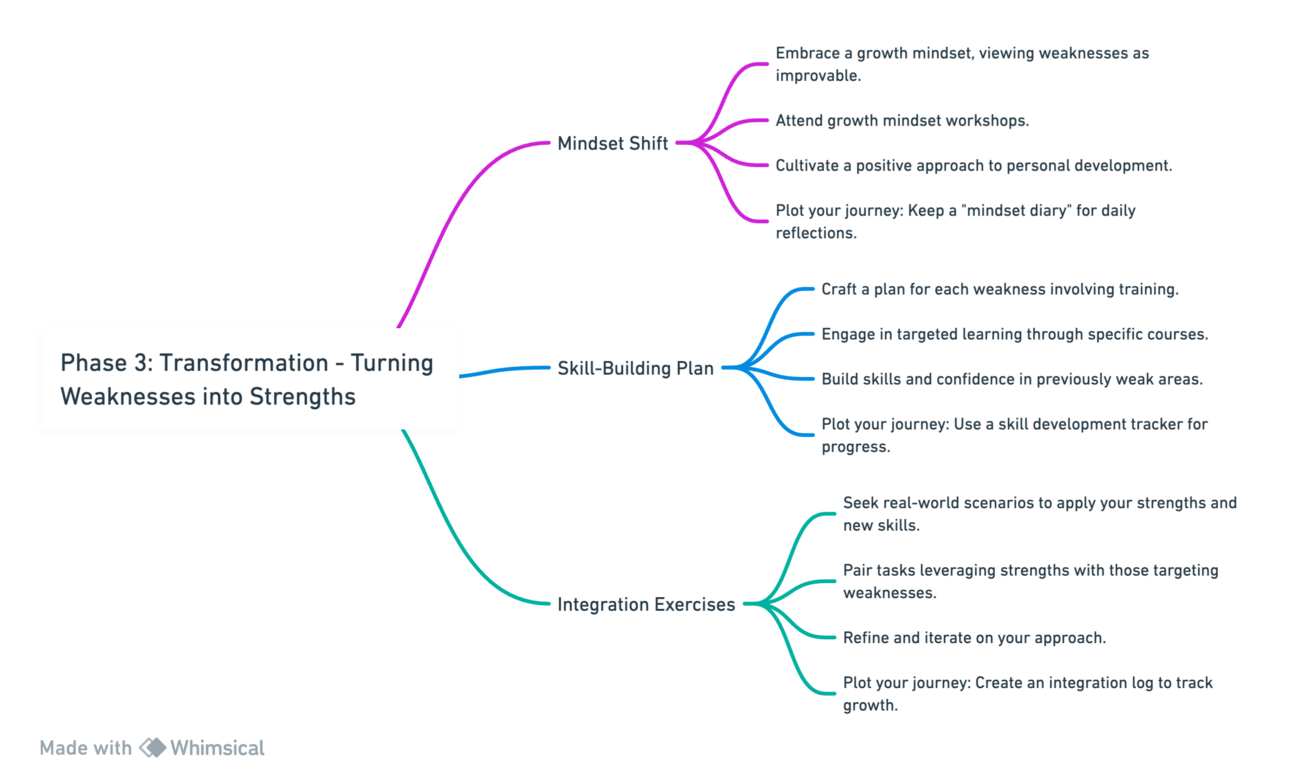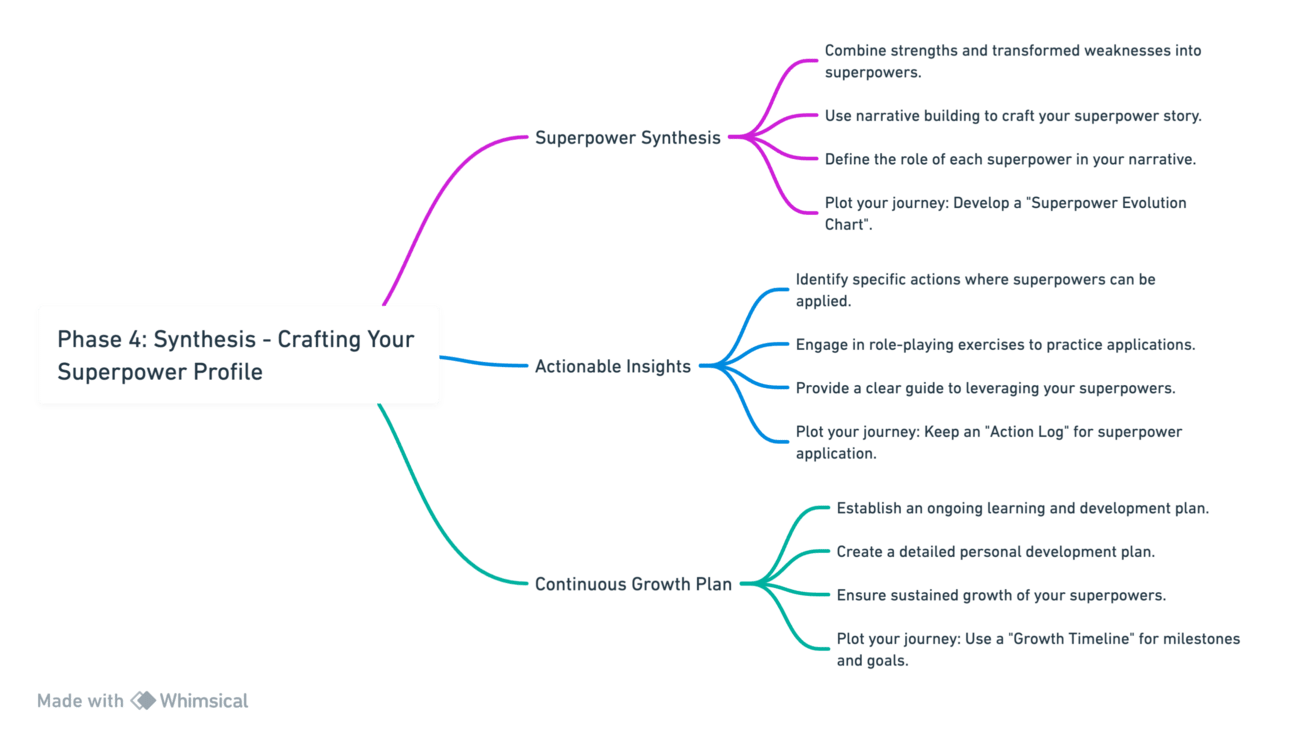- DedeDumdum
- Posts
- Applying the Personal Superpowers Framework (PSF) - A step by step guide
Applying the Personal Superpowers Framework (PSF) - A step by step guide
With its five-phase approach, from Discovery to Application, the PSF guides you through self-reflection, analysis, transformation, synthesis, and finally, the real-world application of your newfound superpowers.

Embark on an empowering journey with the Personal Superpowers Framework (PSF) – your gateway to unlocking and harnessing the unique strengths that lie within you. The PSF offers a structured yet flexible path to not only discover and enhance your inherent talents but also to transform your perceived weaknesses into formidable strengths. With its five-phase approach, from Discovery to Application, the PSF guides you through self-reflection, analysis, transformation, synthesis, and finally, the real-world application of your newfound superpowers.
😞 Your pain points: Is this you?
Discovering one's personal superpowers is not just an exercise in self-affirmation; it's a strategic move towards navigating life more effectively. Here are some typical problems that you might also be facing:
Feeling Stuck in a Rut:
Many feel trapped in their current personal or professional situations, unable to see a way forward. Understanding their unique strengths can illuminate new paths and opportunities.
Lack of Fulfillment:
Even those who are successful by conventional standards often experience a sense of emptiness. Discovering and leveraging their superpowers can lead to more meaningful and fulfilling endeavors.
Ineffective Problem-Solving:
Repeatedly facing obstacles with the same ineffective strategies can be frustrating. Recognizing one's unique problem-solving abilities can transform challenges into opportunities.
As someone who's journeyed through the realms of architecture, product design, and UX, I've seen firsthand how design thinking isn't just about creating things; it's about solving life's puzzles. So, grab your metaphorical capes, and let's dive in.
Let’s break down your daily life’s spheres of influence into 6 broad categories; career, relationships, health, finances, family and business.
Before you start, you might want to check out the DO IT model that drives the framework.
Let’s dive straight in.
💭 Phase 1: Discovery - Unearthing Your Innate Strengths
This phase is crucial for building self-awareness, as it helps you to identify and acknowledge your natural talents and abilities, forming the foundation of your personal superpowers.

Self-Reflection Inventory
Step 01: Reflect on life's moments where fulfillment and success were your companions.
Step 02: Choose journaling as your method to capture these moments daily.
Step 03: Aim to identify recurring themes or skills that contributed to these fulfilling experiences.
Step 04 - Plot your journey: Create a journal entry template that includes sections for the date, the specific experience, the emotions felt, and the skills used. Over time, review your journal entries monthly to visually map out the frequency of certain skills and emotions, identifying patterns and growth in specific areas.
Feedback Loop
Step 01: Seek input on your strengths from your network.
Step 02: Implement a 360-Degree Feedback process.
Step 03: Discover patterns and skills you may have overlooked.
Step 04 - Plot your journey: Use a feedback collection tool to categorize and quantify the types of strengths mentioned by different groups (peers, mentors, family). Plot these on a graph to see which strengths are most frequently recognized, and note any changes or new strengths identified over subsequent feedback rounds.
Strengths Assessment
Step 01: Engage with tools like StrengthsFinder for professional insight.
Step 02: Opt for online strengths assessments.
Step 03: Gain a structured understanding of your inherent strengths.
Step 04 - Plot your journey: After completing the assessment, chart your top strengths and their descriptions. Revisit and retake the assessment yearly to plot changes or developments in your strengths profile, reflecting on experiences that may have influenced these changes.
🍩 Phase 2: Analysis - Understanding Your Weaknesses
Understanding your weaknesses is essential for personal growth, as it allows you to recognize areas for improvement and development, setting the stage for transformation.

Weakness Identification
Step 01: Reflect deeply on challenges and less confident moments.
Step 02: Choose reflective journaling to document these instances.
Step 03: Acknowledge and understand these weaknesses.
Step 04 - Plot your journey: Maintain a separate section in your journal for challenges, noting the context, your reactions, and the outcome. Review this section quarterly to identify any recurring weaknesses, plotting their frequency and any patterns in context or reaction.
Pattern Recognition
Step 01: Detect recurring themes in your challenges.
Step 02: Utilize mind mapping to organize and connect areas of weakness.
Step 03: Acknowledge and understand these patterns.
Step 04 - Plot your journey: Create a mind map that starts with broad categories of weaknesses and branches out into specific instances or themes. Update this map with new branches as you identify more patterns, visually tracking your growth and areas of persistent challenge.
🌈 Phase 3: Transformation - Turning Weaknesses into Strengths
This transformative phase is key to resilience and adaptability, enabling you to reframe and enhance your weaknesses into strengths, thus expanding your capabilities and potential.

Mindset Shift
Step 01: Embrace a growth mindset, viewing weaknesses as improvable.
Step 02: Attend growth mindset workshops.
Step 03: Cultivate a positive approach to personal development.
Step 04 - Plot your journey: Keep a "mindset diary" where you jot down daily reflections on how you approached challenges. Use symbols or colors to mark entries where you successfully applied a growth mindset versus a fixed mindset. Review and plot the ratio monthly to visualize your mindset evolution.
Skill-Building Plan
Step 01: Craft a plan for each weakness involving training or new challenges.
Step 02: Engage in targeted learning through specific courses.
Step 03: Build skills and confidence in previously weak areas.
Step 04 - Plot your journey: Use a skill development tracker, listing skills, related courses or activities, and progress levels. Update this tracker after each learning activity, plotting your progression from novice to proficient in each skill area.
Integration Exercises
Step 01: Seek real-world scenarios to apply your strengths and new skills.
Step 02: Pair tasks leveraging your strengths with those targeting your weaknesses.
Step 03: Refine and iterate on your approach.
Step 04 - Plot your journey: Create an integration log, detailing each real-world application, the strengths and weaknesses involved, and the outcome. Rate the success and comfort level of each integration, plotting these ratings over time to see your growth and areas needing more work.
😎 Phase 4: Synthesis - Crafting Your Superpower Profile
Synthesizing your strengths and transformed weaknesses into superpowers is vital for defining your unique value proposition, allowing you to articulate and leverage your distinct abilities in various aspects of life.

Superpower Synthesis
Step 01: Combine your strengths and transformed weaknesses into superpowers.
Step 02: Use narrative building to craft your superpower story.
Step 03: Define the role of each superpower in your narrative.
Step 04 - Plot your journey: Develop a "Superpower Evolution Chart" where each superpower is listed along with its origin story (how it was developed). Update this chart as you refine or discover new superpowers, plotting your journey towards a more empowered self.
Actionable Insights
Step 01: Identify specific actions where your superpowers can be applied.
Step 02: Engage in role-playing exercises to practice these applications.
Step 03: Provide a clear guide to leveraging your superpowers.
Step 04 - Plot your journey: Keep an "Action Log" where you record instances of superpower application, the context, actions taken, and the outcomes. Review this log to identify the most impactful applications and plot adjustments to maximize your superpower efficacy.
Continuous Growth Plan
Step 01: Establish an ongoing learning and development plan.
Step 02: Create a detailed personal development plan.
Step 03: Ensure sustained growth of your superpowers.
Step 04 - Plot your journey: Use a "Growth Timeline" to plot milestones, learning goals, and achievements related to your superpowers. Regularly update this timeline to reflect your continuous growth journey, highlighting new learning opportunities and areas of improvement.
🔥 Phase 5: Application - Living Your Superpowers
The application phase is critical for actualizing your potential, as it involves integrating your superpowers into your daily life and career, ensuring that you live in alignment with your true capabilities and aspirations.

Personal Branding
Step 01: Infuse your personal and professional branding with your unique superpowers.
Step 02: Develop a personal brand statement that encapsulates your superpowers.
Step 03: Communicate your unique value proposition through your resume, LinkedIn profile, and personal pitch.
Step 04 - Plot your journey: Create a "Branding Evolution Chart" where you document iterations of your personal brand statement, LinkedIn headline, resume summaries, etc., over time. Note the feedback or opportunities each version attracts and plot the correlation between specific superpower highlights and professional opportunities or recognitions.
Strategic Networking
Step 01: Connect with communities and networks where your superpowers can flourish.
Step 02: Engage in interest-based networking to find like-minded individuals and groups.
Step 03: Foster mutual growth and opportunities through strategic relationships.
Step 04 - Plot your journey: Maintain a "Networking Growth Log" detailing each significant networking event, the connections made, and any follow-up actions or outcomes. Use this log to plot the expansion of your network and the role your superpowers played in fostering these new connections.
Goal Alignment
Step 01: Align your personal and career goals with your superpowers for maximum leverage.
Step 02: Use goal mapping to ensure your objectives resonate with your superpowers.
Step 03: Position yourself in roles and projects where your strengths can shine brightest.
Step 04 - Plot your journey: Develop a "Goals and Achievements Tracker" that lists your short-term and long-term goals alongside the superpowers you plan to leverage for each. Update this tracker with milestones reached and plot the alignment between goal achievement and superpower application, noting any adjustments needed to stay on course.
Applying the PSF should not intimidate you because it's fundamentally about embracing your authentic self, warts and all. It's an invitation to celebrate your victories, learn from your challenges, and continuously strive towards being a better version of yourself, without the pressure of perfection. So, approach the PSF with curiosity, openness, and the understanding that it's a tool for empowerment, not a stringent test of your worth. Remember, the journey of self-improvement is a marathon, not a sprint, and every step forward, no matter how small, is a victory in itself.

Print it out!